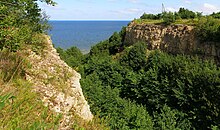Saka (Kohtla)
Coordinates: 59 ° 26 ' N , 27 ° 14' E

Saka (German Sackhof ) is a village ( Estonian küla ) in the rural municipality Kohtla ( Kohtla vald ). It is located in Ida-Viru County ( East Wierland ) in northeast Estonia .
Description and history
The village has 133 inhabitants (as of January 1, 2010). It is ten kilometers north of the city of Kohtla-Järve on the Estonian Baltic coast.
At the cliff is the 47.5 meter high Saka waterfall ( Saka joastik ), which consists of three larger and several smaller cascades . The water supply was artificially created in the middle of the 19th century via a two meter deep ditch.
Saka was first mentioned in 1241 in the Liber Census Daniae . A first estate was probably built around this time. In the Middle Ages it was expanded into a vassal castle or a fortified house. However, there are no structural traces left.
The Saka hoard is a silver hoard discovered in 2015 in Saka by a probe.
Good saka
The Saka manor has been documented elsewhere since the 17th century. In 1629 the Swedish King Gustav II Adolf gave the estate to Jörgen Letzle (John Leslie) from Scotland . After his death in 1651 it passed to his son Rittmeister Alexander Wilhelm Leslie (approx. 1631–1667) and from this to the grandson Alexander Wilhelm von Leslie (approx. 1658–1721). The latter was a colonel in the army of Duke Georg Ludwig von Braunschweig-Lüneburg , who ruled as King George I (Great Britain) of Great Britain from 1714 . After that, the estate remained in the possession of members of the Leslie family, who sold it to the Baltic aristocratic Wrangel family in 1646 . After the death of the major, district chief and hook judge Jürgen Gustav von Wrangel in 1809, it was acquired by the noble Löwis of Menar family, originally from Scotland , who owned it until it was expropriated as part of the Estonian land reform in 1919.
The two-storey mansion in the neo-renaissance style was completed as the center of the estate in 1864. The central tower with its tall, narrow windows was characteristic of the building.
With the occupation of Estonia by the Red Army , a pioneer camp first moved into the mansion and then the Soviet border troops. They declared the area on the steep coast to be a restricted military area.
The buildings and the extensive park of the estate have been preserved to this day. After Estonian independence was regained in 2000, some of them were extensively restored and sold by the Estonian state to a private owner. Today there is a wellness hotel in an outbuilding of the estate. A visitor center for the cliffs of northern Estonia is to be built in the manor house.
literature
- Bunz, Rainer: from Leslie - Scottish nobility in Germany and Austria. With numerous illustrations. Norderstedt: BoD-Books on Demand 2018, 256 pages; in particular Chapter 4 "The Leslies von Sackhof", pp. 135-176, the first account of the history of the Baltic noble family Leslie.
Web links
Individual evidence
- ↑ http://www.eestigiid.ee/?CatID=275&ItemID=831
- ↑ http://www.eestigiid.ee/?SCat=43&CatID=0&ItemID=1708
- ↑ http://www.mois.ee/viru/saka.shtml
- ↑ See Bunz 2018, p. 174 ff.
- ↑ http://www.manor.ee/?id=923&manor_id=27
- ↑ Archived copy ( Memento of the original from July 13, 2011 in the Internet Archive ) Info: The archive link was inserted automatically and has not yet been checked. Please check the original and archive link according to the instructions and then remove this notice.


